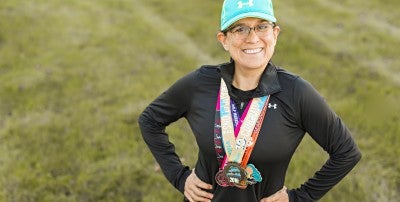
Agnes Hardy-Boyer loves to run. From a 20-kilometer race along the northwest coast of France to a 5K run in the Lehigh Valley, Hardy-Boyer enjoys setting new personal bests. But exercise wasn’t always easy for the Easton resident.
In 2013, Hardy-Boyer was alarmed at how quickly her stamina and strength were sapped during activities like biking or squash. “I became tired and out of breath,” she says. Tests for heart disease and Lyme disease were negative. The unexplained fatigue was unrelenting, even during light exercise. “I would ask myself, ‘What’s wrong with me?’” she says.
The heart of the problem
Her primary care physician sent her to a cardiologist, who suspected hypertrophic cardiomyopathy (HCM), a sometimes fatal thickening of the heart muscle. HCM is linked to sudden cardiac arrest in athletes.
In late 2013, she came to Lehigh Valley Heart and Vascular Institute for treatment of what was thought to be HCM. Instead of HCM, however, the cardiology team found a flap of tissue beneath her aortic valve that was restricting blood flow out of her heart, causing her troubling symptoms. This ‘subaortic membrane’ is most commonly found in children and is often repaired with surgery, though it sometimes requires a replacement for the aortic valve.
Going from surgery to boundless energy
LVHN cardiothoracic surgeon James Wu, MD, operated on Hardy-Boyer in May 2014 to remove the membrane. This cleared the passage for blood flow out of her aortic valve – no valve replacement needed.
Soon after, she was exercising again without the excessive fatigue that had plagued her. As her energy surged, she took up running − a sport she had avoided for years. “I didn’t like running the hills at first, but soon I was finding them easier,” she says.
Today, Hardy-Boyer goes to the gym three times a week and runs in races as often as she can, estimating she has completed a dozen events since her surgery including the Dorney Park Half Marathon in October 2016 and the Delaware and Lehigh (D&L) Heritage Trail Half Marathon in November 2016. Her big accomplishment was reaching her goal of running at least 1,000 kilometers (621 miles) in October 2016.
“I feel healthier than ever,” she says. “I can do anything I want without being tired, thanks to to my Lehigh Valley Heart and Vascular Institute care team.”
The value of a second opinion
As Agnes Hardy-Boyer found, a second opinion from Lehigh Valley Heart and Vascular Institute pinpointed the exact cause of her extreme fatigue – a diagnosis that differed from the original one she received.
LVHN cardiothoracic surgeon James Wu, MD, says a second opinion can provide peace of mind. “Having another physician agree with the diagnosis and course of action should give you confidence in a difficult situation. And sometimes a second opinion might yield a different diagnosis or treatment option as well. It happens more often than you might think,” he says.
Keep this advice in mind when seeking a second opinion.
- Check with your health insurance provider to see if it requires a second opinion and to determine what the coverage is for second, third or more opinions.
- Find a provider with at least the same level of expertise or greater if possible, meaning a specialist in the field of your condition.
- Find one who works with a different medical institution or network.
- If the second opinion differs significantly from the first, consider a third or fourth opinion.
“Don’t ever hesitate to ask your provider about getting a second opinion when discussing your health or the health of someone you love. In the end, the correct diagnosis and treatment always is what matters most,” Wu says.
